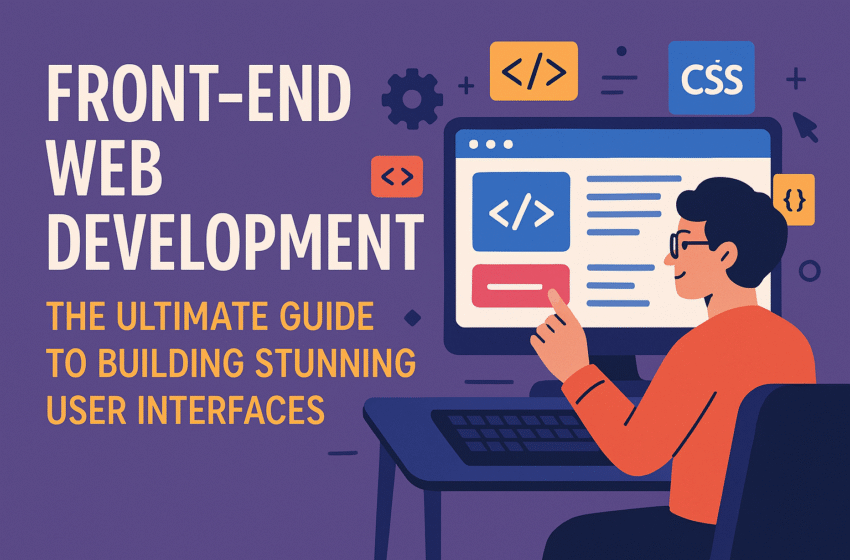

Front-end web development is the heartbeat of today’s digital experience. Every website you interact with whether it’s a sleek e-commerce store or a personal blog owes its appeal and interactivity to front-end web development. If you’ve ever clicked a button, scrolled through a beautifully styled page, or filled out a responsive form, you’ve witnessed front-end magic in action.
In this post, we’ll dive deep into what front-end web development really means, why it matters, and how you can become proficient in it. Whether you’re a complete beginner, a curious tech enthusiast, or someone exploring a career shift, you’ll find this guide both comprehensive and practical.
What is Front-end Web Development?
Front-end web development is the process of creating the visual part of a website or application the part users see and interact with directly. It involves using technologies like HTML, CSS, and JavaScript to structure content, design layouts, and add interactivity.
Think of it this way: if a website were a house, front-end development would be the paint, furniture, windows, doors, and lighting the things you experience first-hand. The back-end (server-side) would be the plumbing, wiring, and foundation.
Common Responsibilities of a Front-end Developer
- Designing responsive layouts that adapt to screen sizes.
- Ensuring cross-browser compatibility.
- Writing clean, maintainable code using HTML, CSS, and JavaScript.
- Collaborating with UX/UI designers and back-end developers.
- Optimising page speed and performance.
- Implementing interactive features like dropdowns, sliders, modals, etc.
The Core Technologies of Front-end Web Development
To truly understand front-end development, we need to break down the core tools that every front-end developer uses:
1. HTML (HyperText Markup Language)
This is the backbone of any website. HTML structures the content like headings, paragraphs, links, and images. Without HTML, web pages wouldn’t exist.
<h1>Welcome to My Website</h1>
<p>This is a sample paragraph explaining front-end development.</p>
2. CSS (Cascading Style Sheets)
While HTML structures a page, CSS styles it. Colours, fonts, layouts, and animations all handled with CSS. It’s how you transform a bland page into a beautiful experience.
body {
font-family: 'Poppins', sans-serif;
background-color: #f8f8f8;
color: #333;
}
3. JavaScript
Now for the fun part interactivity! JavaScript breathes life into websites by allowing you to manipulate content in real-time. It lets you respond to user actions like clicks, scrolls, form submissions, etc.
document.querySelector("#btn").addEventListener("click", () => {
alert("You clicked the button!");
});
Modern Tools and Frameworks in Front-end Development
The front-end world is constantly evolving. Here are some of the tools and libraries developers use today:
1. Frameworks and Libraries
- React: A JavaScript library by Facebook. It helps build user interfaces with components.
- Vue.js: Lightweight and beginner-friendly.
- Angular: A full-fledged front-end framework maintained by Google.
Each of these has its pros and cons, but React currently dominates the job market and ecosystem.
2. CSS Frameworks
- Bootstrap: A responsive CSS framework.
- Tailwind CSS: A utility-first CSS framework that’s great for building custom designs fast.
3. Package Managers and Build Tools
- npm (Node Package Manager): Allows you to install libraries and tools.
- Webpack, Vite, and Parcel: Tools for bundling and optimising your code.
Why Front-end Web Development Is a Valuable Skill
The internet is growing—fast. With billions of users online and businesses going digital at lightning speed, front-end developers are more in demand than ever.
Here’s Why You Should Consider It:
- Remote Opportunities: Many front-end developers work from anywhere.
- Creative Freedom: It blends coding and visual design—perfect for creative minds.
- High Demand: According to Stack Overflow’s Developer Survey, front-end web development remains one of the most sought-after tech roles.
- Freelance Potential: Build websites for clients and grow your own business.
- Quick Start: You don’t need a computer science degree to begin. Platforms like Pegon Academy offer step-by-step guides to help you start building immediately.
How to Learn Front-end Web Development in 2025 (Beginner’s Roadmap)
Step 1: Master the Basics (HTML, CSS, JS)
Spend 2–3 months building simple projects like:
- A personal portfolio website
- A to-do list app
- A responsive landing page
Step 2: Learn Version Control (Git & GitHub)
Git lets you track changes, collaborate with others, and deploy projects easily. GitHub is the platform to host your repositories.
Step 3: Dive into Responsive Design
Learn to make websites mobile-friendly using media queries and frameworks like Bootstrap or Tailwind CSS.
Step 4: Pick a JavaScript Framework
Start with React—it’s beginner-friendly and widely used in the job market.
Step 5: Build Projects
Nothing beats hands-on experience. Try building:
- A weather app using an API
- A blog platform with a CMS
- A single-page application (SPA)
Step 6: Learn Deployment
Use platforms like:
- Netlify (free and beginner-friendly)
- Vercel (great for React apps)
- GitHub Pages
Front-end Developer Career Paths
You can wear many hats as a front-end developer depending on your interest:
- UI Developer: Focus on implementing beautiful designs.
- Front-end Engineer: Heavily focused on logic and performance.
- Mobile Front-end Developer: Using tools like React Native.
- Accessibility Engineer: Ensures the web is inclusive for users with disabilities.
You can even transition into full-stack development or UX/UI design over time.
Real-world Applications of Front-end Development
From online shops to AI dashboards, front-end developers shape how users interact with technology. Here are a few industries where front-end skills are key:
- E-commerce: Beautiful storefronts and seamless checkout flows.
- Healthcare: Patient dashboards and appointment systems.
- EdTech: Platforms like Pegon Academy rely on front-end interfaces to deliver learning experiences.
- Fintech: Interfaces for managing money, investments, or crypto.
The Human Side of Front-end Development
Here’s the thing—front-end development isn’t just about code. It’s about empathy.
You’re designing experiences for people. People who are visually impaired. People on slow connections. People who don’t speak English natively. This emotional awareness shapes great developers.
It’s easy to get lost in the technical side—writing perfect code and chasing frameworks—but never forget who you’re building for.
And hey, sometimes your layout won’t look right on Firefox. Sometimes a button won’t work on mobile. You’ll scratch your head, Google everything, maybe cry a little (we’ve all been there). That’s okay. That’s growth.
Conclusion: Your First Step Toward Front-end Mastery
Front-end web development is more than a job skill—it’s a gateway into tech. It gives you the power to build, design, and impact lives from a browser window. Whether you’re freelancing, job-hunting, or building your own startup, front-end skills open doors.
Feeling inspired? Don’t wait.
Take your first step today at Pegon Academy—we’ve got beginner-friendly courses to get you building confidently from day one.
Quick Recap
| Topic | Summary |
|---|---|
| What is Front-end Dev? | Building user-facing parts of websites using HTML, CSS, and JS. |
| Core Tech Stack | HTML (structure), CSS (style), JavaScript (interactivity). |
| Tools and Frameworks | React, Vue, Tailwind CSS, npm, Git. |
| Learning Path | Basics → Git → Responsive Design → React → Projects → Deployment. |
| Career Opportunities | UI Dev, Front-end Engineer, Mobile Dev, Accessibility Expert. |
| Real-world Impact | E-commerce, EdTech, Fintech, Healthcare platforms. |
FAQ: Front-end Web Development
Is front-end development hard to learn?
It can feel overwhelming at first, but with consistency and project-based learning, most people can get job-ready in 6–12 months.
Can I become a front-end developer without a degree?
Absolutely. Many developers today are self-taught. What matters most is your portfolio and ability to build real-world projects.
What’s the average salary?
In 2025, junior front-end developers earn anywhere from $45,000 to $80,000 annually, depending on location and experience. Senior developers can make well over $120,000.




